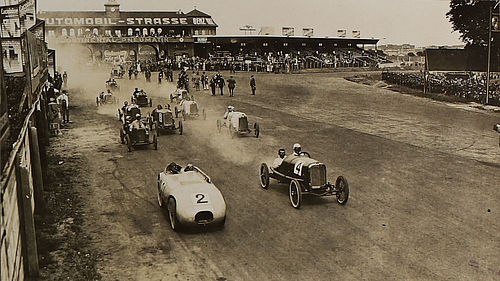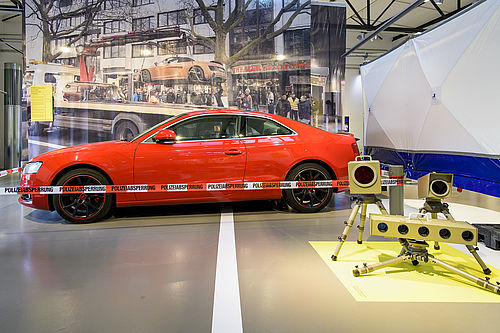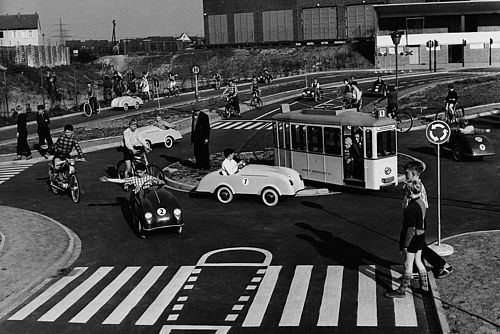Social Roots of the Speeding Craze

SDTB / Historisches Archiv
Where does this speeding frenzy in our car culture come from? Why do people take part in illegal street races? What are the possible countermeasures that can be taken?
Illegal street racing is considered the pinnacle of reckless speeding on the roads. The death of a bystander in Berlin in 2016, which made headlines as the “Kudamm street race case,” was a drastic reminder of this. Although legislation and law enforcement have been reinforced, the number of incidents still continues to rise. Berlin records an average of 800 to 900 cases per year. Yet the phenomenon of excessive speed is neither new nor limited to illegal races. The exhibition's perspective ranges from the historical and social roots of speeding in our automotive culture to the measures taken to effectively prevent illegal street racing. This also includes modern driver assistance systems.
Der Jeep von Michael Warshitsky, der am 1. Februar 2016 als Opfer eines illegalen Autorennens starb. Der sogenannte Kudamm-Raser-Fall hatte einen starken Einfluss auf die Gesetzgebung und Rechtsprechung in Bezug auf illegale Autorennen.
SDTB / M. Scherf
Für schwere Unfälle wie dem Kudamm-Raser-Fall erstellen Gutachter detaillierte Animationen. Bordcomputer liefern heutzutage wichtige Daten über die letzten Sekunden vor dem Aufprall.
Unfallgutachter Priester & Weyde
Die Polizei Berlin nutzt dieses Motorrad für ihre Programme zur Unfallprävention. Es gehörte einem Berliner, der 2013 bei einem Einzelrennen im Tiergartentunnel starb. Seine Ehefrau überließ die Maschine der Polizei, um auf die Gefahren des Rasens aufmerksam zu machen. Im Hintergrund ein enteignetes Raser-Fahrzeug.
SDTB / M. Scherf
Along with many smaller objects, display boards and media stations, there are also several wrecks from illegal car races on display. The central object of the exhibition is the accident victim's car from the Kudamm racer case. That accident triggered a change in the way illegal street racing is adjudicated. It was, for example, the first time that street racers were convicted of murder. In addition, in 2017 a paragraph addressing “Prohibited motor vehicle racing” was added to the penal code. The museum exhibition features vehicles from accidents in which people died in order to demonstrate the dangers of illegal racing and speeding in general. In doing so, it builds on the experience of the Berlin police, which has been using a crashed motorcycle for accident prevention purposes for many years. The exhibition's presentation of vehicles that belonged to victims of illegal street racing is supported by the bereaved families.
What are the prevailing values in our automobile culture?

SDTB / M. Scherf
The exhibition also takes a look at the development of the prevailing values that glorify speed, competition, and antiquated ideals of masculinity in our automotive culture, in which the ideal of a strong man hardened by competition is still omnipresent. The 1990s saw the steadily increasing horsepower in cars suddenly make a gigantic leap: The automotive industry was pushing the performance and speed of its vehicles ever higher while leased, rented and used cars now made it possible for many more people to drive really fast cars. Popular culture also gave new impetus to the horsepower and speed craze: The tuner car scene became more popular and interest in Formula 1 racing grew at an unprecedented rate in Germany. Computer games with increasingly realistic-looking races also came onto the market. And music videos to this day like to show satisfied men in fast cars being adored by scantily clad women.
How can illegal street races be stopped?

pa / ullstein bild
As a result of the increased incidents of illegal car racing and the tragic accidents of recent years, efforts to curb this form of speeding have intensified. However, only some of the measures are directed exclusively against illegal car racing. Many of the proposals take aim at speeding in general: tougher laws, tougher law enforcement, and a form of traffic education that puts more emphasis on speeding and its dangers.

SDTB / Foto: Clemens Kirchner
There is also a focus on technical solutions such as automatic speed limit controllers in the vehicle. The necessary driver assistance systems, also known as Intelligent Speed Assistance, will become mandatory in all new vehicle types in the European Union beginning in 2022, although until further notice they can be switched off. The discussion about driver assistance systems revolves around fundamental social issues: Can a problem caused by technology be stopped by more technology? Do driver assistance systems limit the accountability and freedom of citizens? Or are they necessary in view of the rising number of accidents?
At the end of the exhibition, visitors are invited to utilize the designated media station to give their opinion on these and other issues surrounding illegal car racing and the speed craze in our automotive culture.
The exhibition was created in cooperation with the Berlin police.
